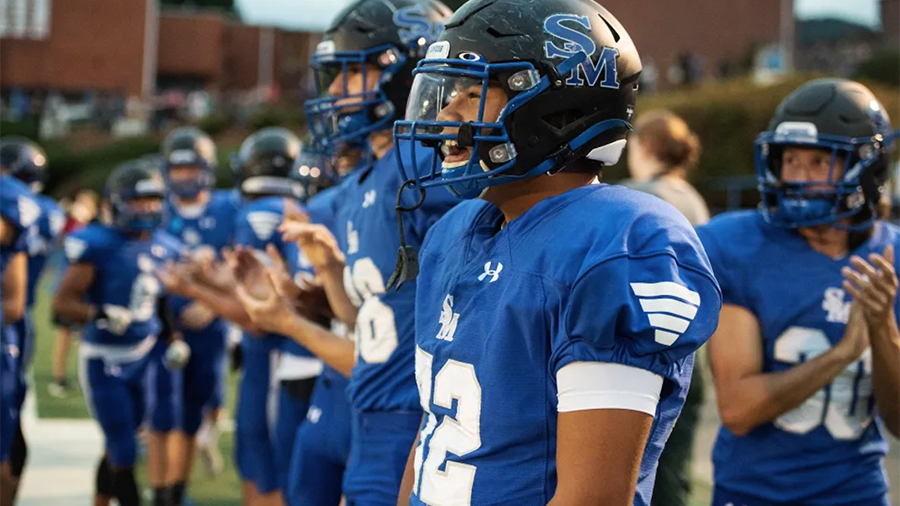In its first high school sports participation survey in three years, the National Federation of State High School Associations (NFHS) reported a total of 7,618,054 participants in high school sports for 2021/22, down four percent from its 2018/19 figure of 7,937,491. However, NFHS noted that participation is “on the road back” after schools could not offer programs in typical fashion during portions of the 2019/20 and 2020/21 school years in the U.S. due to the pandemic.
The pandemic interrupted the sports participation data the previous two years, making its 2021/22 survey the organization’s first official report since 2018/19.
The 2021/22 total comprises 4,376,582 boys and 3,241,472 girls, according to figures obtained from the 51 NFHS member state associations, including the District of Columbia.
“Given what has occurred in our country the past three years, we believe a decline of only four percent in participation totals from 2018/19 is pretty remarkable,” said Dr. Karissa Niehoff, CEO of the NFHS, in a statement. “We know some states that were able to complete surveys in 2020/21 reported participation increases this past year. So, we are very optimistic that trend will continue in the years to come as schools fully recover from the effects of the 2020 shutdown.”
Among the Top 10 boys sports in participants from 2018/19, golf was the only sport to register an increase, up just under four percent with 148,585 participants and surpassing tennis as the eighth-most popular sport.
Golf was among the few sports to increase for boys and girls. Participation by girls was up one percent to 80,829 participants.
The biggest storyline for boy’s participation totals was football. While boys 11-player football was down three percent, 1,006,013 to 973,792, less than the overall survey average of four percent, participation in 6-, 8- and 9-player football registered a 12 percent increase from 31,221 to 34,935. The slight movement from 11-player to other versions was also seen in school sponsorship. While the number of schools with 11-player football dropped by 514 (14,247 to 13,733), the number of schools offering 6-, 8- or 9-player football increased by 227 (1,563 to 1,790).
Gains by girls playing football were greater. In all four versions of the game (11, 9, 8, 6), girl’s participation increased 39 percent from the 2018/19 survey, 2,604 to 3,633. The increase in girl’s flag football was 40 percent, 11,209 to 15,716.
In total, boys and girls participation in all versions of football decreased 2.2 percent from 1,051,047 to 1,028,976.
“Certainly, the football numbers are encouraging after the previous report from the 2018/19 season,” Niehoff said. “The movement from 11-player to other versions of the game continues to be attractive to schools in some states, and the growth of girls flag football continues to gain ground in more areas of the country.”
Baseball had the best showing among Top 10 boys sports from the 2018/19 survey, with a decrease of 1,736, (482,740 to 481,004), and remained fourth in popularity behind football, outdoor track and field and basketball.
The other change for boy’s Top 10 sports was wrestling, which nudged cross country for sixth place at 231,874 to 231,387.
Wrestling was down six percent from the previous survey, while cross country had the biggest decline at 14 percent.
Other boy’s sports outside the Top 10 that experienced significant gains from 2018/19 were volleyball, up 4.6 percent, and bass fishing, up by 10,626.
Volleyball continued its rise in popularity among girl’s sports and was the only Top 10 sport to increase from three years prior with 454,153 participants. Volleyball is only 2,500 participants behind track and field for the No. 1 participatory sport for girls.
The emerging sport of girls sand/beach volleyball increased from 2,237 to 6,489 participants.
Among other girl’s Top 10 sports, soccer moved ahead of basketball to No. 3 behind track and field and volleyball, with softball remaining fifth. Cross country, swimming and diving and competitive spirit registered the biggest decline in the past three years among Top 10 sports with a 13 percent drop.
Flag football and girl’s wrestling continued their recent surge in popularity with a 50 percent increase since 2018/19 (21,124 to 31,654). Thirty-two U.S. states now offer separate state wrestling championships for girls.
While most of the traditional sports experienced some decrease since 2018/19, the 2021/22 survey showed a dramatic rise in Unified sports participation. With only 5,541 combined participants from 10 states in 2018/19, this year’s survey showed 47,909 combined participants in almost 20 states.
In addition to Unified sports participants, the survey’s data showed another 7,689 combined participants in Adapted sports. The 55,598 combined participants in Unified and Adapted sports represent a 163 percent increase from three years ago.
“It is great to see a growing interest in several emerging sports, as well as programs like Unified and Adapted programs,” Niehoff said. “Our goal continues to be to involve as many students as possible in high school sports and other activity programs.”
This year’s survey indicated participation by high school students in 69 different sports, as well as 16 Adapted sports and 16 Unified sports. In addition to those previously noted, some of the more popular Other sports (combined participation numbers) were bowling (57,219), field hockey (56,091), ice hockey (42,092), water polo (37,379), and weightlifting (25,257).
With an increase of about 20,000 participants, Texas topped the list of state participation with 846,161. Texas was one of 14 states that had a gain in participation since the 2018/19 survey. California retained the No. 2 position with 762,823 participants despite a drop of more than 60,000 from three years ago.
Other changes in the Top 10 show Ohio moving to No. 3 with 378,354 participants, followed by Pennsylvania (315,097), Illinois (314,839), New York (313,404), Florida (291,504), Michigan (271,423), New Jersey (264,139), and Massachusetts (215,848).
The NFHS High school Athletics Participation Survey began in 1971 and was compiled in its current form through the 2018/19 school year and now resumes annually with the 2021/22 survey.
















